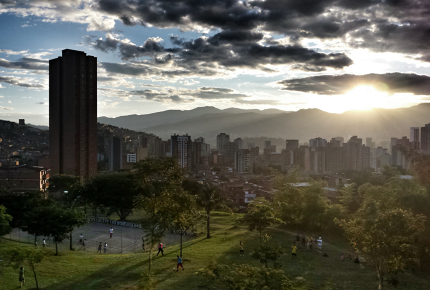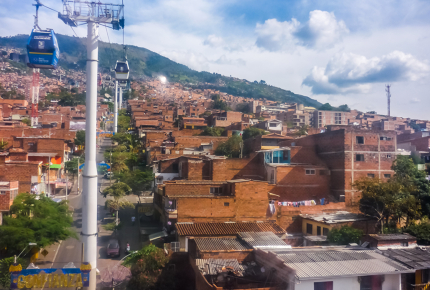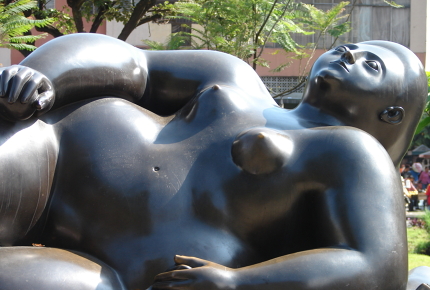Medellín: A cocaine capital in rehab
Decades of violence saw Medellín ranked as the world’s most dangerous place, but now Colombia’s second city has staged a remarkable comeback. How did it do it, asks Darren Loucaides.
On 2 December 1993, a hail of bullets brought cocaine kingpin Pablo Escobar tumbling to the tiles as he fled over rooftops from police agents. With him toppled an unparalleled reign of narcoterrorism that had turned Medellín, the seat of his multi-billion dollar empire, into the most dangerous city on Earth.
Two decades on, Colombia’s second city has staged a remarkable comeback, and was named Innovative City of the Year by the Urban Land Institute in 2013. So just how did a capital of violence turn into a city icon?
Following Escobar’s death, different factions and opponents warred over his legacy, but by the 2000s, security improved and the government embarked on ambitious regeneration programmes.
Paisas, as locals are known, reclaimed former no-go areas; state-of-the-art libraries and museums opened. Architectural parks and giant art were unveiled across the sprawling metropolis as modern skyscrapers began outshining any colonial characteristics.
Today the city, located in northwest Colombia, 444km (276 miles) from Bogotá, feels like a gigantic gallery with colossal sculptures and dazzling metro station murals. That’s thanks – in part – to people like former mayor Sergio Fajardo who sought to remake Medellín’s visual fabric.
He brought the crime-ridden barrios (neighbourhoods) along Medellín’s mountainous periphery back into the fold through pioneering projects like the Metrocable, a gondola that carries 30,000 commuters a day from the barrios to the city.
 Medellín was once the world’s most dangerous city
Medellín was once the world’s most dangerous cityCreative Commons / Ivan Erre Jota
“Things are changing fast here,” says Carlos Estrada, a restaurateur whose latest venture is Bonuar, a bistro housed within the Museum of Modern Art. “Ten years ago there were only traditional restaurants in the city,” he adds, “now there’s a whole wave of places that I would call gastronomic.”
Serving the likes of lobster cooked in rum and sugarcane, even the food symbolises Medellín’s current resurgence.
The museum has breathed new life into the once desolate, post-industrial area of Ciudad del Río. Now, creative types in skinny jeans mill around the gallery’s immersive installations and bracing video art.
That evening I hole up at Charlee, a boutique hotel situated in Parque Lleras, Poblado’s main square. But my accommodation is as much an art gallery as a hotel.
“Every floor is taken over by a different artist,” says Norha Tamayo, Charlee’s art director, as I admire the work of Teresa Currea, who has depicted surreal scenes using paper cut-outs in wooden boxes.
Over cocktails on its hip rooftop bar, Tomayo explains that there’s an exciting hub of local artists in Medellín right now. From here, its tumultuous past seems to belong to another city altogether.
However, tourists still come to Medellín to hear about its gory past. Paisa Road runs a Pablo Escobar tour that refuses to glorify the bloody-minded villain.
Driving around the heaving metropolis, we visit various areas associated with Escobar, including the apartment his enemies blew up and his grave. Our guide pulls no punches. He was a narcissist who cared for no one but himself, she says, a paedophile who lured young girls by gifting them mopeds.
The uncompromising guide claims that everyone in her generation knows someone killed during the troubles. At the height of Escobar’s reign, there were an incredible 380 murders per 100,000 people. What’s more, she says, we Westerners (specifically those who’ve indulged in a cheeky line) are to blame. “Every – one – of – you,” she drawls with disdain, “has Colombian blood on your hands.”
The hives of vice fuelled by cocaine have been reclaimed by Paisas, not least downtown’s Parque de las Luces. Once dominated by pimps and junkies, today it’s a gleaming square of 300 light beams. A nearby whorehouse has been turned into a library that looks like a spaceport.
There’s a similar feeling of redemption in Santo Domingo. The barrio, which Escobar ruled like a personal fiefdom, has improved greatly since being linked to the city by the Metrocable. Its shining modern library sticks out among the rugged hillside houses.
 The Metrocable take commuters from barrios to the city
The Metrocable take commuters from barrios to the cityRudimencial / Thinkstock
“Are you sure?” he croaks, puffing on a cigarette. “It’s very dangerous.”
With attendants on each level, I feel safe enough as I ascend past little houses pumping out Latin music, their walls painted with bright murals by local graffiti artists. I see old ladies hanging out their washing and boys kicking around a football.
The summit offers a majestic view of red-orange houses and skyscrapers scaling the slopes of the verdant Aburrá Valley. From here, it’s easy to see why Medellín is called the Land of Eternal Spring.
Back at street level, colossal black-painted figures hulk beneath the towering office blocks. They’re the work of Medellín’s patron saint of art, Fernando Botero. The local artist started donating his work to the city in 2010, further helping the rebirth of Medellín.
In the plaza outside Museum of Antioquia, where a whole floor is dedicated to Botero, a woman enhanced by the surgeon’s knife (another of Escobar’s legacies) leans against the artist’s voluptuous depiction of Venus.
The Antioquia area feels very different from the gleaming 4x4s and chic locales of Poblado. Downtown’s roads are choked with honking cars on the brink of collapse and tired-looking workers heading home.
As twilight settles, I go in search of Botero’s most poignant work, the Bird of Peace. I ask a young guy with slicked-back hair for directions to Plaza de San Antonio and he warns me that thieves operate in the area.
People are sat on the steps surrounding the square, most of them drinking bottled beer. The only people by the sculpture are a German couple snapping away. It hardly feels risky.
Botero’s gargantuan bird statue was blown up here in 1995, killing 23 and injuring hundreds. Rather than let it be removed, Botero insisted that the imploded husk remain, with the victims’ names inscribed on a plaque.
Next to it stands a pristine replica bird. It’s the very point at which Medellín’s terrible past and promising future converge. One is a dark reminder, the other a symbol of hope.
 A Fernando Botero statue in Medellín
A Fernando Botero statue in Medellín Creative Commons / Ivan Erre Jota
NEED TO KNOW
Getting there
There are no direct flights from the UK to Medellín. Instead, fly to Bogotá with Avianca (www.avianca.com) for a connecting flight to Medellín. The internal flight takes about an hour.
Where to stay
Apart from its artistic appeal, rooms at Charlee (www.thecharleehotel.com) offer private teppanyaki grills and Jacuzzis. Doubles start from £150.
More information
For an introduction to Medellín that doesn’t gloss over the past, try Real City Tours (www.realcitytours.com).
Do you have any Feedback about this page?
© 2025 Columbus Travel Media Ltd. All rights reserved. No part of this site may be reproduced without our written permission, click here for information on Columbus Content Solutions.









 You know where
You know where